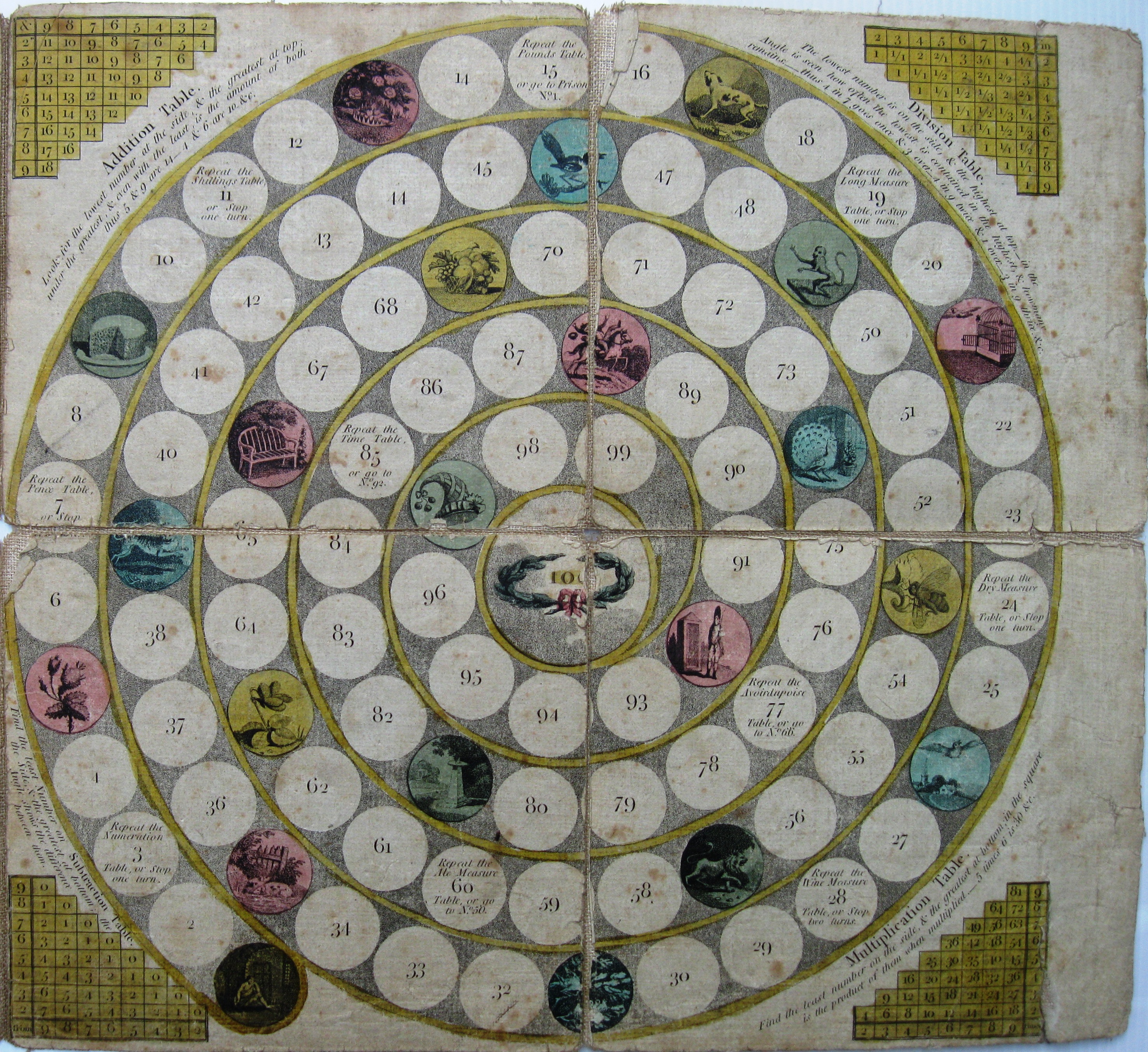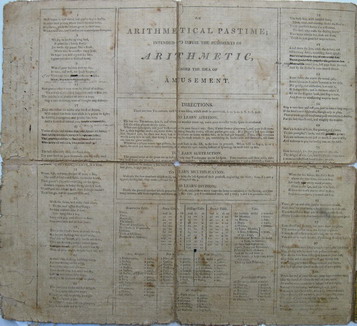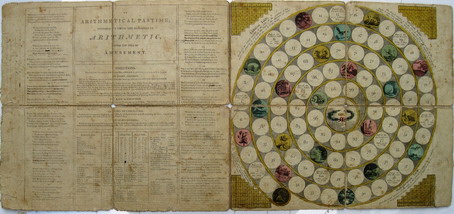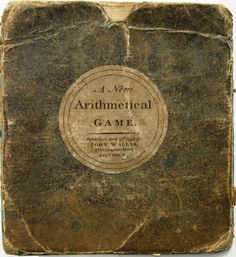Giochi dell'Oca e di percorso
(by Luigi Ciompi & Adrian Seville)
(by Luigi Ciompi & Adrian Seville)

|
Giochi dell'Oca e di percorso
(by Luigi Ciompi & Adrian Seville) |

|
 |

Torna alla ricerca giochi (back to game search) |
 |
| Arithmetical (An) Pastime Intended to Infuse the rudiments of Arithmetic under the idea of Amusement | ||
 |
Versione stampabile
 |
Invia una segnalazione

|
   |
primo autore: | Taylor C. (1791) |
| secondo autore: | Wallis | |
| anno: | 1798 | |
| luogo: |
Inghilterra-Londra |
|
| periodo: | XVIII secolo (4°/4) | |
| percorso: | Percorso di 100 caselle numerate | |
| materiale: | carta incollata su tela (engraving on paper with linen backing) | |
| dimensioni: | 344X723 | |
| stampa: | Litografia colorata a mano (hand-coloured lithograph) | |
| luogo acquisto: | ||
| data acquisto: | ||
| dimensioni confezione: | ||
| numero caselle: | 100 | |
| categoria: | Infanzia, educazione, pedagogia, favole e fiabe | |
| tipo di gioco: | Gioco di percorso | |
| editore: | Published April 19th. 1798 by John Wallis, N°16 Ludgate Street, London (Re-issued by Edward Wallis) | |
| stampatore: | Printed from type by T. Gillet, printer, Salisbury Square, Fleet Street | |
| proprietario: | Collezione A. Seville | |
| autore delle foto: | A. Seville | |
| numero di catalogo: | 2210 | |
| descrizione: |
Gioco di 100 caselle numerate, spirale (circolare), orario, centripeto. REGOLE: al retro. CASELLE: alcune con didascalia. NOTA: vedi anche esemplare Arch. n°1273. REFERENZA 1 "An Arithmetical Pastime Intended to Infuse the rudiments of Arithmetic under the idea of Amusement". (V&A Museum). First published in 1791, this race game is 'intended to infuse the rudiments of arithmetic, under the idea of amusement'. There are 100 playing spaces and the game is surrounded by addition, subtraction, multiplication and division tables with directions for their use. The game begins with a thinking man and ends with a laurel wreath. The forfeits are designed to make a player repeat certain tables. Some are obvious, such as the times table, and some less so, the wine measure, for example. Others such as the avoirdupois table (the weights table of ounces and pounds) are obscure today. Physical description Design: engraving, coloured by hand; 6 sections mounted on linen, 100 compartments, some numbered some with emblems, diagrams and tables in corners N° of squares: 100 Squares illustrated: some Square numbering: some Squares titled: all Subject of starting square: a man thinking Subject of ending square: laurel wreath Place of Origin: London Date: 19/04/1798 Artist/maker: Wallis, John Materials and Techniques: Hand-coloured engraving, mounted on linen Dimensions: Length: 34.4 cm; width: 72.3 cm Object history note: Re-issued by Edward Wallis Historical context note Rewards: forward movement, extra turns Forfeits: backward movement, missing turns N°of Players: any Equipment required: teetotums, pyramid/marker and 4 matching counters - THESE ARE SIMILAR TO TOUR THROUGH ENGLAND AND WALES , AND EUROPE Rules: DIRECTIONS The two teetotums must be numbered 0-9. Each player is to be furnished with one pyramid or marker and four round counters of the same colour. To learn addition: Use but one teetotum, spin it and whatever number it turns up, move your traveller to the space so numbered. Let the other players do the same. When you spin it again, add your fresh number to your former one: thus if your former place was six and your fresh number 5, they together make 11, move there, spinning thus by turns, till one person gets 100. If a player's last spin carries him beyond 100, he does not win, but is to return as many on this side as he had got beyond; thus if his number would carry him to 108, that being 8 too many, he must return to 92, continuing so backwards and forwards, till someone hits the game exactly. Whenever a player comes to a picture, he must look at the list, to see how to proceed. When told to stop 1, 2, or 3 turns, he must put down so many counters, and when his turn comes, instead of spinning, he must take one up. To learn subtraction: The general rules of the game are as before, only both teetotums are to be spun. Two numbers will then arise, take the least from the greatest, and move with the remainder. If for instance, the numbers 7 and 4, subtract 4 from 7 and 3 remains, to number 3 you must go; if the next 9 and 5 arise, subtract and 4 remains, which added to you former place brings you to 7. To learn multiplication: Multiply the two numbers which arise, move with the last figure of their product, neglecting the other: thus if 5 and 9 appear, multiplied they make 45 - use the 5 and neglect the 4. To learn division: Divide the greatest number which come us by the least, observe how many times the latter is contained in the former and how many remain, add these together and move with their sum. Five and eight are contained one and 3 over; 3 and 1 is 4, move there. The compartments containing pictures, such as a cake, tiger, sentry, peacock, are not numbered although they fit into the numerical sequence. The sheet of rules has a list of the penalties or benefits to be gained by a player who lands on a picture. *First published on December 15th, 1791 by C. Taylor and reissued in 1798 by John Wallis. The forfeits refer to repeating sertain tables, some of which are obvious - the times table- and some less so - the wine measure - while others such as the avoirdupois table (weights table of ounces and pounds) are obscure now. In the corners are the addition, subtraction, multiplication and division tables and directions for their use. If a player could not pay the forfeit he or she had the choice of missing turns or moving backwards. The same game was issued in 1798 by John Wallis . Thereafter An Arithmetical Pastime had quite different rules. Two teetotums were required to learn the mathemetical disciplines. The players subtracted the number shown on one teetotum from the number on the other (which ever was greatest), or multiplied the two numbers shown and used the last number of the result for their move, or divided the two numbers and used the result plus the remainder for their move. Used in parallel with these directions were the compartments on the playing sheet. Each had an accompanying verse to be read out and further rewards or forfeits. Thiswas a game that could teach everything-morals, history, geography and arithmetic. Rules placement: to the left side Descriptive line: Hand coloured mathematical race game, Arithmetic Pastime, published in England by John Wallis in 1798 Attribution Note: Previously published by C Taylor in 1791. Printed by Biggs & Co, Crane Court, Fleet Street REFERENZA 2 WHITEHOUSE, Francis Reginald Beaman, (pag. 33): ARITHMETICAL PASTIME Intended to Infuse the rudiments of Arithmetic under the idea of Amusement. An engraving size 14 in X 12 ½ in, mounted with rules, etc., printed from type by T. Gillet, printer, Salisbury Square, Fleet Street. These rules are the same size as the engraving, making a sheet 28 in X 12 ½ in, mounted in 8 sections on linen, and contained in a slip-in case with circular label on front entitled “A New Arithmetical Game, Published April 19th, 1798 by John Wallis, No 16 Ludgate Street, London". Not only were the rudiments of arithmetic infused, but those of moral values also, e.g. No 57: “Loud roars the lion while the deserts vast Of burning Afric, trembling stand aghast: Power to destroy is his, if you would have Power greater still, pray for the power to save. Meanwhile avoid him, lest your heart he rend And fly for safety to your nearest friend.” Or 81: “When the sun shines, the dial’s shade Shows the true time, nor ever lies. Let truth your every word pervade Clear as the sun, and you’ll be wise. If from the truth you’ve erred to-day Stop thrice-if not, you need not stay." REFERENZA 3 "Un jeu pour enseigner les mathématiques a été édité le 15 décembre 1791 par C. Taylor. Intitulé "An Arithmetical Pastime" (Un divertissement arithmétique), ce jeu est une gravure peinte à la main qui se trouve composé de 100 cercles, certains illustrés et d'autres avec des indications et des gages. Ces derniers consistent à répéter certaines tables numériques; certaines sont faciles -les heures par exemple- et d'autres moins -comme le tableau des poids et mesures (en livres et onces). Dans les coins se trouvent les tables d'addition, de soustraction, de multiplication et de division ainsi que les instructions. Si un joueur ne pouvait pas exécuter son gage, il ou elle pouvait choisir entre passer son tour et reculer. Le meme jeu a été édité en 1798 par John Wallis. Par la suite, les règles du "Divertissement arithmetique" ont changé. On avait besoin de deux totons pour apprendre les disciplines mathématiques. Les joueurs soustrayaient le nombre montré sur le toton du nombre de l'autre (quel que soit le plus grand) ou multipliaient les nombres et utilisaient le dernier nombre du resultat pour avancer ou divisaient les deux nombres et utilisaient le résultat pour avancer. Les compartiments du tableau sont utilisés en parallèle avec les directions. Chacun d'eux comprenait une phrase à lire, des gages et des récompenses. C'était un jeu qui enseignait tout - la morale, l'histoire, la géographie et l'arithmétique." (GOODFELLOW Caroline) REFERENZA 4 "Published on December 15th, 1791 by C. Taylor was a game for teaching mathematics. The game is a hand-coloured engraving titled "An Arithmetical Pastime". There are 100 circles, some of which contain illustration while others have directions and forfeits. The forfeits refer to repeating certain tables, some of which are obvious - the time table, for exemple - some less so - the wine measure table, for instance - while others, such as the avoirdupois table (the weights table of ounces and pounds), are obscure today. In the corners are the addition, subtraction, multiplication and division tables and directions for their use. If a player could not pay the forfeit he or she had the choice of missing turns or moving backwards. The same game was issued in 1798 by John Wallis. Thereafter "An Arithmetical Pastime had quite different rules. Two teetotums were required to learn the mathematical disciplines. The players subtracted the number shown on one teetotum from the number on the other (whichever was greatest), or multiplied the two numbers shown and used the last number of the result for their move, or divided the two numbers and used the result plus the remainder for their move. Used in parallel with these directions were the compartments on the playing sheet. Each had an accompanying verse to be read out and further rewards or forfeits. This was a game that could teach everything - morals, history, geography and arithmetic." (GOODFELLOW Caroline) Exhibitions: - "Instruction and Delight: Children's Games from the Ellen and Arthur Liman Collection" (Yale Center for British Art, 17 January-23 May, 2019). |
|
| bibliografia: |
1) WHITEHAUSE, F.R.B.: "Table Games of Georgian and Victorian Days", London, Peter Garnett, 1951. 2) GOODFELLOW, Caroline: "A Collector's Guide to Games and Puzzles". Secaucus, New Jersey, Chartwell Books-London, Quintet Publishing Limited 1991. 3) GOODFELLOW, Caroline: "The Development of the English Board Game, 1770-1850", in Board Games Studies 1, 1998. 4) GOODFELLOW, Caroline: "Jeux de société. Le guide du collectionneur des jeux de société depuis le XVIIIe siècle jusqu’à nos jours", (Edizione francese) Carrousel MS, 2001. 5) SEVILLE, Adrian: "The Game of Goose: and its influence on cartographical race games" Journal of the International Map Collectors' Society, Winter 2008 N°115 2008. 6) SEVILLE, Adrian: "The geographical Jeux de l'Oie of Europe." In "Belgeo" 2008 3-4 2008. 7) GOODFELLOW, Caroline: "How We Played: Games From Childhood Past", History Press, 2012. 8) QUINN, Brian - CARTWRIGHT, William: "Geographic Board Games". Geospatial Science Research 3. School of Mathematical and Geospatial Science, RMIT University, Australia. December 2014. 9) SEVILLE, Adrian: "The Royal Game of the Goose four hundred years of printed Board Games". Catalogue of an Exhibition at the Grolier Club, February 23 - May 14, 2016. 10) LIMAN, Ellen: "Georgian and Victorian Board Games: The Liman Collection", Pointed Leaf Press, 2017. 11) NORCIA, Megan A.: "Gaming Empire in Children's British Board Games, 1836-1860". Studies in Childhood, 1700 to the Present. Routledge, 2019. |
|
| "The Development of the English Board Game, 1770-1850" (Caroline G. Goodfellow) | ||
| Instructional Games. "Table Games of Georgian and Victorian Days". (Francis Reginald Beaman, Whitehause) | ||
Vai alla ricerca giochi Vai all'elenco autori